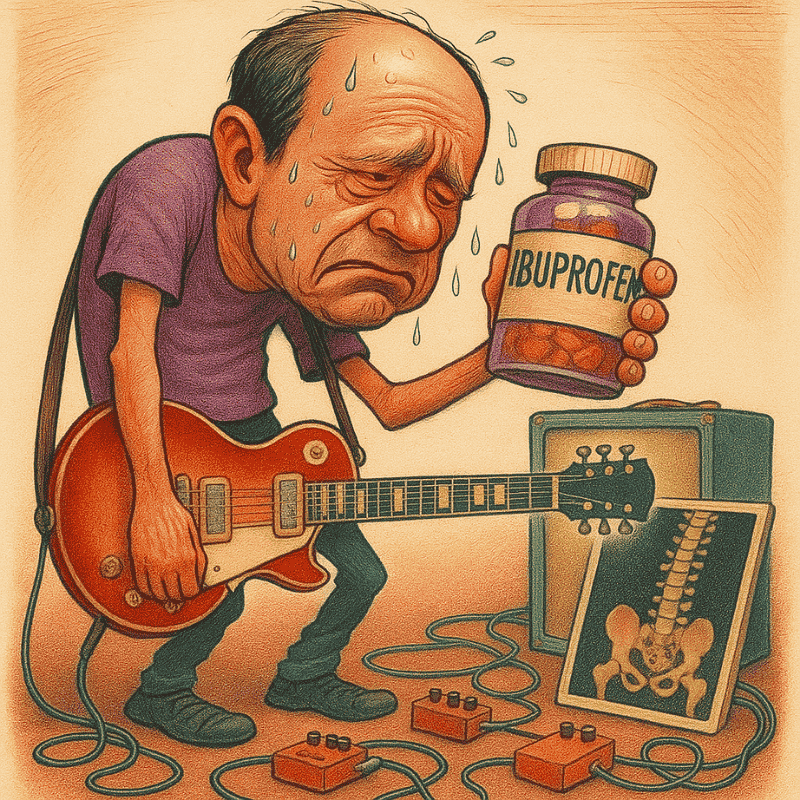If you’ve ever peeled off a strap after a gig and found a red trench in your shoulder, or finished a three-hour rehearsal hunched over like Gollum, then yeah - this article is for you.
For a lot of us, the right strap didn’t become “a thing” until our backs started throwing tantrums. Whether you’re lugging a 10-pound Les Paul or a neck-heavy bass that just won’t quit, the wrong strap can slowly turn your passion into a pain fest. And if you’re over 35? Your back starts negotiating terms like a union rep after two songs.
We’ve been there - aching shoulders, back stiffness, and that nagging “maybe I’m holding this thing wrong” feeling. Whether you’re gigging every weekend, noodling on the couch, or grinding through rehearsal, the right strap can mean the difference between powering through a set or tapping out early. So let’s talk comfort - what works, what doesn’t, and how to keep your playing pain-free no matter how long you’re on your feet.
Why Guitar and Bass Straps Can Make or Break Your Back
Look, nobody starts playing guitar or bass because they want better posture. You pick it up to make noise, feel something, and maybe annoy your neighbors. But fast forward a couple decades, and suddenly, how your instrument sits on your body matters almost as much as how it sounds.
For electric players especially, the weight of your axe adds up. Guitars like the Strat, SG, or Jazzmaster are usually manageable, but if you're toting a Tele, Les Paul, a P-Bass, or one of those ash-bodied monsters from the '70s, your strap becomes the only thing between you and a chiropractor’s wet dream.
And the thing is, most stock straps - especially the freebies - are total garbage. Skinny, slippery, non-padded nylon that feels like someone’s holding a cheese wire to your shoulder? No thanks.
The good news? There’s a smarter way to stay comfy. Whether you're dealing with shoulder pain, neck dive, or just that “why does this hurt?” feeling after a long session, we're about to dig into what really makes a strap comfortable - and how to find one that works for your body, your instrument, and your playing style.

Comfort Starts with the Right Strap Width and Padding
If your strap feels like it's trying to slice your collarbone in half, chances are it’s too narrow, or too flimsy for the job. One of the easiest ways to upgrade your comfort is by simply widening the load. Literally.
Wide straps, especially those in the 2.5- to 4-inch range, spread the weight of your guitar or bass over a larger area. That means less pressure on any single point and way less shoulder fatigue after a long session. This is especially crucial if you're slinging something hefty, like a vintage Les Paul or a full-scale bass. A narrow strap on a heavy instrument is like using dental floss to tow a car.
But width alone isn’t the full story. Padding matters too - a lot. Straps with built-in cushioning (think memory foam, neoprene, or gel inserts) act like a buffer between you and the instrument’s weight. They don’t make your axe any lighter, but they do make it feel that way. It’s like upgrading from a wooden stool to a padded throne - your spine will notice.
And here’s where materials come into play. Leather straps are popular for their durability and the way they conform to your shoulder over time. That said, not all leather is created equal - some are stiff, heavy, or just plain sweaty. On the other side, you’ve got cotton and hemp straps, which are soft, breathable, and tend to feel less like you’re wearing a seatbelt. Nylon can work too, but avoid the shiny seatbelt-style ones unless you enjoy your guitar slipping like it’s been buttered.
Moral of the story? Look for something wide, padded, and made of a material that doesn’t try to escape mid-song.

High or Low? Why Strap Height Can Make or Break Your Comfort
Let’s get one thing straight: slinging your guitar down to your knees might look cool on a punk poster, but it’s a shortcut to wrist pain, shoulder tension, and possibly needing a bottle of ibuprofen just to get through a set.
The way your guitar or bass hangs on your body massively affects your posture and how much strain you’re putting on your arms, wrists, and back. If you’ve got your strap adjusted so low you’re doing yoga just to hit a barre chord, your body will start filing complaints - fast.
For the most ergonomic setup, your instrument should sit close to where it naturally lands when you’re sitting down. This keeps your fretting wrist at a healthier angle and your picking hand relaxed. It also lets your shoulders drop instead of hunching forward like you’re guarding a secret.
A good rule of thumb? Set your strap while sitting, then stand up and see if the guitar stays in the same spot. If it suddenly feels like it’s on a bungee cord, adjust until it doesn’t. This way, your technique stays consistent whether you’re jamming at home or playing out live - and your body will thank you.
This isn’t about choosing “high” or “low” like it’s a lifestyle - it's about dialing in your sweet spot. Somewhere between jazz cat and metalcore slinger lies a position that won’t mess with your spine.

Even When You’re Sitting, Your Strap Has a Job to Do
A lot of players think straps are just for standing gigs. Not true. If you’ve ever tried to play sitting down without a strap, you probably noticed your instrument sliding around, neck diving off your leg, or your picking hand doing weird angles just to keep everything in place.
Using a strap while seated isn’t just about convenience - it’s about stability. A properly adjusted strap keeps your guitar or bass at a consistent height and position, whether you're on a bar stool or on stage. This consistency means your hands know where to go, your posture stays solid, and you’re not constantly fighting to keep the instrument from doing the limbo.
It also takes the weight off your lap and lets your spine and shoulders relax a bit - especially helpful during long practice sessions or when you're recording take after take. You’ll stay more focused on playing and less on babysitting your gear.
Think of it this way: your strap is part of your rig. If you’re skipping it just because you’re sitting, you’re making it harder on yourself than it needs to be.

Bass vs. Guitar Straps: Is There Really a Difference?
Let’s clear this up once and for all: a strap is a strap. There’s no hidden mystical design that separates “guitar” from “bass” straps - just good marketing and a few size tweaks. What really matters is weight support, not the label on the packaging.
Bass guitars tend to be heavier and longer, so straps marketed toward bassists are often wider and more padded. That’s it. It’s not like there’s a secret bass-only strap guild keeping these things off guitars.
In fact, many of the most comfortable straps for bass work just as well - if not better - for heavy guitars like Les Pauls or thick-bodied semi-hollows. The real trick is picking a strap that distributes weight well, cushions your shoulder, and stays in place. If that means grabbing something called a “bass strap” for your Telecaster, do it. Your shoulder doesn’t care about semantics - it cares about survival.
So don’t overthink the label. Think about the weight of your instrument, how long you’re wearing it, and what your body is telling you after a few songs. That’s the only real difference that matters.

Staying Comfortable During Long Gigs or Practice Marathons
You know that feeling - hour two of a set, your shoulder’s screaming, your back’s stiff, and suddenly even G chords feel like deadlifts. This is where comfort stops being a luxury and becomes pure survival.
The first weapon in your arsenal? A wide, padded strap. Seriously, if your strap’s built like a belt, you’re asking for pain. Wider straps distribute weight more evenly, and padding acts like a shock absorber for your shoulder. Combine the two, and you’ll go from “why do I do this to myself?” to “let’s add another set.”
Strap height is another big player. If your guitar or bass is slung too low, your body has to compensate. That means hunching forward, twisting your wrist, or keeping tension in your neck and shoulders - none of which feels great three songs into a 15-track setlist. Adjust your strap to a height where everything feels natural. If you can’t hit a barre chord without looking like you’re doing Tai Chi, it’s too low.
Posture matters, too. Try not to crane your neck downward or hunch over like a gremlin guarding tone secrets. Stand straight, let the strap do the heavy lifting, and keep your hands relaxed. Bonus tip: if you’re doing a really long session, sneak in breaks between songs - stretch, breathe, maybe complain about drummers for a minute. It helps.
And hey - if you’ve got a few different guitars or basses, rotate them. A slightly lighter instrument can give your body a break without killing your tone.

Fighting Neck Dive Like a Pro (Without Gluing Your Bass to Your Shirt)
Ah, neck dive. That magical moment when your headstock decides it’s more interested in the floor than your audience. If you’ve ever played a Thunderbird, SG, or certain basses from the “chunky body, featherweight neck” era, you know the struggle.
The good news? Your strap can actually help - if you pick the right one.
What you want is friction. A strap with a grippy underside - like suede, textured neoprene, or even some woven fabrics - will cling to your shoulder and keep things stable. This extra grip slows down the slide and keeps your neck from doing its signature Swan Dive of Doom. Bonus: it also helps keep your strap in place during those high-energy sets when your whole body’s moving.
What you don’t want is the smooth stuff. Some straps look sleek but slide around like a greased pig in a kiddie pool. Nylon “seatbelt” styles and some smooth leather straps might feel nice at first, but they’re not doing you any favors if your instrument’s front-heavy.
Now, let’s be honest - a grippy strap isn’t going to completely eliminate neck dive if your instrument’s seriously unbalanced. But it will massively reduce how often you’re manually lifting the neck back into position. And if you pair it with good posture and the right strap height? You’ll barely notice it’s a problem.

When a Standard Strap Isn’t Enough: Other Comfort Hacks That Work
Sometimes, even a wide, padded strap just doesn’t cut it. Maybe you’ve got old injuries, chronic shoulder pain, or you’re just built in a way that standard straps don’t work with. Good news: there are ergonomic upgrades that can make a huge difference - and they don’t require surgery or selling your gear collection.
First up: double-shoulder harness straps. These bad boys distribute the weight of your guitar or bass across both shoulders, kinda like wearing a backpack. They’re especially useful for heavier instruments and players with back or neck issues. Yeah, they look a little tactical - but when you’re deep into a two-hour gig and still feeling fresh, you won’t care.
If you don’t want to fully commit to a dual-strap setup, try adding an aftermarket shoulder pad to your existing strap. These velcro-on gel or memory foam pads give you some extra squish right where you need it most. They’re also great for converting an old favorite strap into something more gig-worthy.
Another tip: watch your strap angle and attachment points. If your instrument naturally wants to tilt or shift, you can sometimes fix the balance by tweaking where and how the strap connects - especially if your strap pins are in weird spots (looking at you, Guild Polara).
Bottom line: don’t tough it out. If you’re still uncomfortable after trying a quality strap, there are tools out there designed to help. Your music deserves your best - and so does your spine.

Beyond Padded Straps: Why Zero Gravity Changes the Game
By now, you’ve probably figured out what separates a “meh” strap from a great one: width, padding, grip, breathability, adjustability - you know, the things your shoulder’s been begging for since that last gig.
But here’s the thing: even most good straps still carry some baggage. They’re often heavy themselves (oh, the irony), trap heat like a wool sweater in July, or come in that “one size fits all” flavor that somehow fits nobody quite right. That’s where the Zero Gravity Strap comes in.
This thing isn’t just another padded strap - it’s a comfort weapon, disguised as gear.
What Makes It Different?
- Featherweight Build – At around 7oz, it’s up to 70% lighter than traditional wide leather straps. Less weight = less strain = more playing.
- Air Cell Studs – On the back of the strap, tiny raised air pods create airflow between your shoulder and the strap. It’s like putting your shoulder on airplane mode: cool, dry, and comfy for hours.
- Moisture-Wicking Neoprene – The padded section pulls sweat away instead of marinating in it. You stay dry, even under stage lights or rehearsal-room pressure cookers.
- Cruelty-Free Luxe – No leather here. Instead, it’s outfitted with premium microfiber PU strap ends that feel and last like the real deal - without smelling like a tack shop or flaking like cheap vinyl.
- Quick-Adjust Buckle – Easily tweak your length mid-set without unhooking your instrument. Great for switching between guitars or adapting on the fly.
- Two Size Options – Because one-size-fits-all doesn’t. Choose from small (42–48") or large (49–63") and get the fit that actually works for you.
In short: it’s designed to disappear while you play - and help you forget what shoulder pain ever felt like.

Ready to Play in Comfort? Your Shoulder Will Thank You
If you’ve ever cut a session short because your body tapped out before your inspiration did, you know how important a great strap is. The Zero Gravity Strap was built for players who refuse to suffer for their sound.
👉 Check out the full Zero Gravity Strap collection here. Whether you're playing for ten minutes or ten hours, your back, your neck, and your inner tone wizard will be glad you did.






